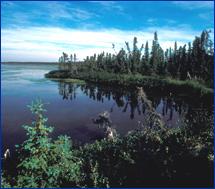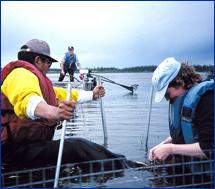Key Concepts Module 1: Overview
This module provides an overview of the water quality standards program under EPA and the States, along with authorized Indian Tribes, which are partners in an effort to protect the Nation's waters. The module provides answers to the following:
- What is the significance of the Clean Water Act?
- How do EPA and the States/Tribes work together toward Clean Water Act objectives?
- What are the components of State/Tribal water quality standards?
At the end of the module is a brief quiz intended to touch on some Core Modules regarding the water quality standards program that will be further examined in the classroom session of this module.
This module's main pages and brief quiz at the end take about 15 minutes to complete.
Stewards of a National Resource
As an important national resource, the condition of lakes, rivers, streams, estuaries, and wetlands throughout the country is a matter of interest for all Americans.
In 1972, with the objective of protecting such waters, the U.S. Congress enacted the Clean Water Act (officially the Federal Water Pollution Control Act). Since enactment, Congress has further strengthened this landmark legislation with amendments.
Congress charged EPA with implementation of the Clean Water Act (CWA), and the Agency issued regulations governing the development, review, and approval of State/Tribal water quality standards. Each State/Tribe, however, plays the primary role in establishing its own water quality standards, with EPA oversight to ensure State/Tribal standards are consistent with the CWA and regulations.
Key Point. States/Tribes are partners with EPA in the effort to restore and protect the Nation's waters through the water quality standards program.
The Clean Water Act
The CWA has both an overall objective and an interim goal:

Overall Objective
The overall objective of the CWA is to "restore and maintain the chemical, physical and biological integrity of the Nation’s waters." Section 101(a).

Interim Goal
The CWA establishes as an interim goal "water quality which provides for the protection and propagation of fish, shellfish and wildlife and provides for recreation in and on the water," wherever attainable. Section 101(a)(2).
Key Point. When enacted, the CWA focused on States and Territories. Amendments enacted in 1987, however, authorized EPA to collaborate with Indian Tribes essentially as States for the purpose of establishing water quality standards on Indian lands. As a prerequisite to developing standards, interested Tribes are required to coordinate with EPA to establish their eligibility as the local governing body responsible for water quality.
Learn More. Relevant provisions of the CWA. Proceed to the Learn More Topic.
EPA’s Role
EPA helps implement the CWA by providing guidance to States and Tribes in the development/revisions of their water quality standards and then conducting final review and approval before States/Tribes can implement them. EPA also provides ongoing support for State/Tribal water quality programs to ensure continued consistency with water quality standards regulations.
Key Point. EPA Regional Offices serve as primary contacts to assist States/Tribes in developing and implementing water quality standards.
Within the Office of Water at EPA Headquarters, the Office of Science and Technology (OST) is responsible for directing the national Water Quality Standards program.
Primary responsibilities include:
- Providing national guidance, including national recommended water quality criteria, for use by EPA Regional Offices, States, and Tribes.
- Promulgating water quality standards when a State or Tribe’s standards have been disapproved.
Other important responsibilities include:
- Supporting Regions as they work with States/Tribes on development and review of water quality standards packages.
- Coordinating water quality standards issues with other water programs (e.g., permits), as necessary.
- Coordinating the Beaches Environmental Assessment and Coastal Health (BEACH) Program, which is focused on improving public health and environmental protection for beach goers and providing the public with information about the quality of their beach water.
Learn More. The role of the other two OST divisions in supporting water quality standards. Proceed to the Learn More Topic.
Regional Guidance & Review
As the primary EPA contact for collaborating with States/Tribes on water quality standards, the EPA Regional Offices are responsible for the following:
- Providing technical assistance.
- Reviewing and then approving/disapproving new or revised water quality standards developed by States and Tribes.
Also:
- Consulting under Section 7 of the Endangered Species Act with the "Services"—the U.S. Fish and Wildlife Service and the National Marine Fisheries Service—as necessary when the State/Tribe's standards may affect listed (i.e. endangered) species.
- Coordinating with EPA Headquarters on water quality standards that the Regional Administrator plans to disapprove.
Resource. To locate a Regional Office, see EPA’s Regional Offices map page.
State/Tribal Responsibilities
Select the links below to view State/Tribal responsibilities regarding water quality standards:
- State/Tribal WQS Responsibility
- Adopt appropriate designated uses (goals for their waters).
- State/Tribal WQS Responsibility
- Adopt necessary water quality criteria to protect designated uses.
- State/Tribal WQS Responsibility
- Adopt an antidegradation policy to help protect existing water quality and high quality waters (consistent with EPA's policy).
- State/Tribal WQS Responsibility
- At their discretion, adopt any general policies as appropriate for application and implementation of standards (e.g., on variances, mixing zones).
- State/Tribal WQS Implementation Responsibility
- Monitor and assess water quality status.
- State/Tribal WQS Implementation Responsibility
- Issue discharge permits (where delegated).
Learn More. Summary of State/Tribal requirements for biennial reporting to EPA on their monitoring and assessment of water quality status. Proceed to the Learn More Topic.
Concepts Applied. Read, as an example, the Tribal water quality standards for Pueblo of Acoma in New Mexico (PDF) (55 pp, 3MB, About PDF)
State/Tribe Specific Components
In developing water quality standards, a State or Tribe needs to establish the following as cornerstones of an effective water quality program. The State/Tribe's standards should take into account its specific water bodies and local circumstances.
Each of these WQS components is covered more fully in the respective modules of this online course. An additional module of the course addresses State/Tribal submission of its water quality standards for review by EPA.
State/Tribal Uses
Water quality standards serve as a foundation for State/Tribal water quality programs. For example, States/Tribes rely on water quality standards when:
- Preparing reports on the water-quality conditions of a jurisdiction's water bodies.
- Providing a target for calculating Total Maximum Daily Loads (TMDLs) for discharges.
- Developing National Pollutant Discharge Elimination System (NPDES) permit limits.
Illustration. View a flow diagram of the water quality-based approach to pollution control. Proceed to the Learn More Topic.
Summary
-
The objective of the Clean Water Act of 1972 (the CWA) is to "restore and maintain the chemical, physical and biological integrity of the Nation's waters."
-
Congress has charged EPA with implementation of the CWA. However, within the context of EPA oversight, each State/Tribe plays the primary role in establishing its own water quality standards.
-
EPA Regional Offices serve as primary contacts for working with States/Tribes in developing and implementing water quality standards.
- States/Tribes are partners with EPA in the effort to restore and protect the Nation's waters through the water quality standards program.
Quiz
To complete your review of the topic in this module, please take the self-assesement quiz by reviewing each question and considering the possible responses.
A note about the quiz:
Your answers will NOT be scored or recorded. However, selecting the Submit button for each question will provide you with the correct answers on screen.
At the end of the quiz is a Get Password button. Select this after you have completed the quiz to obtain one of the six passwords you will need to obtain your Certificate of Completion at the end of the course.
Answer each of the questions below
Disclaimer:
For informational purposes only–Not official statements of EPA policy.
